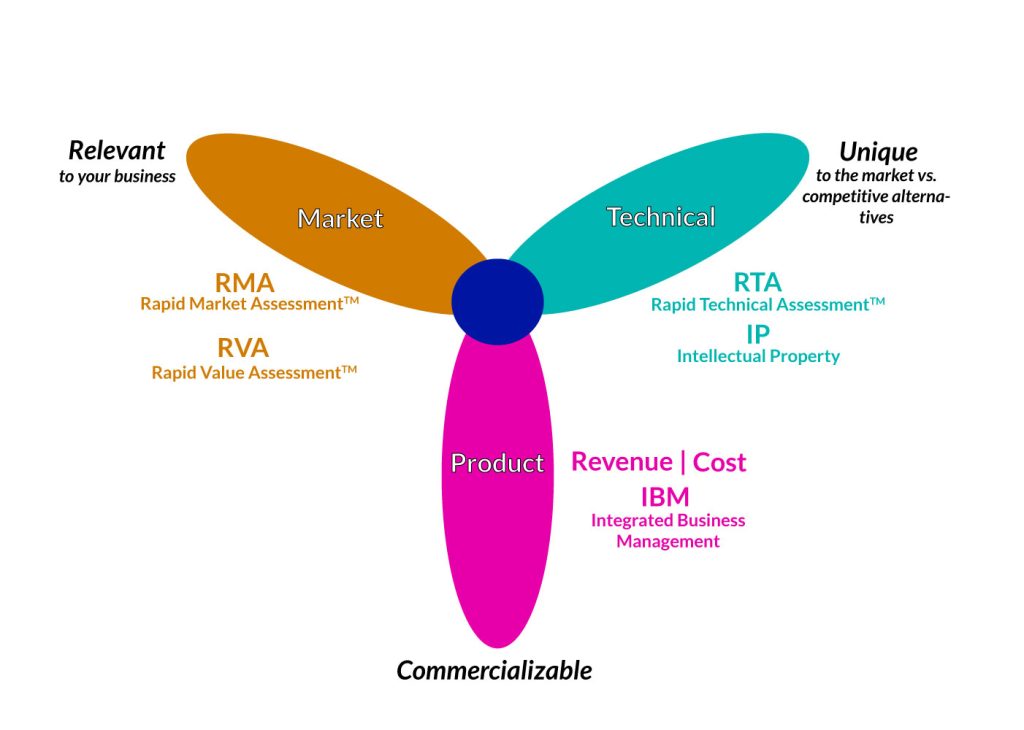[vc_row][vc_column][vc_column_text]
Value vs. Cost vs. Competitor
 As shown in the graphic above, there are three aspects of the opportunity assessment.[/vc_column_text][/vc_column][/vc_row][vc_row][vc_column width=”1/3″][vc_column_text]
As shown in the graphic above, there are three aspects of the opportunity assessment.[/vc_column_text][/vc_column][/vc_row][vc_row][vc_column width=”1/3″][vc_column_text]
- The market is relevant to you and your business. This includes
- Rapid Market AssessmentTM
- Rapid Value AssessmentTM
[/vc_column_text][/vc_column][vc_column width=”1/3″][vc_column_text]
- The technical aspect is unique to the market vs. competitive alternatives. This includes
- Rapid Technical AssessmentTM
- Intellectual Property
[/vc_column_text][/vc_column][vc_column width=”1/3″][vc_column_text]
- The product is commercializable. This includes
- Revenue
- Cost
- Integrated Business Management
[/vc_column_text][/vc_column][/vc_row][vc_row][vc_column][vc_column_text]
Rapid Market Assessment
 The first aspect of the opportunity assessment is the market, which includes the Rapid Market Assessment (RMA). The point of the RMA is to understand new markets aimed at defining a new value proposition—a new offering or a new business tool—that best fits the new market. The RMA provides a recommendation to move forward with or drop the growth opportunity. It’s a summary of the
The first aspect of the opportunity assessment is the market, which includes the Rapid Market Assessment (RMA). The point of the RMA is to understand new markets aimed at defining a new value proposition—a new offering or a new business tool—that best fits the new market. The RMA provides a recommendation to move forward with or drop the growth opportunity. It’s a summary of the
- Scope of the opportunity (how broad, narrow, or focused)
- Value of the opportunity (dollars, units)
- Strategic fit (with whom and how)
- The industry/market, including composition of the market, key players, market drivers, unmet needs, key issues, influencers, and who has the power in the chain
- Characterization of key players who are potential acquisition targets
It’s an initial business hypothesis and value proposition, as well as a summary of other opportunities that may have emerged from the work.[/vc_column_text][vc_column_text]
Rapid Value Assessment
 The Rapid Value Assessment (RVA) is aimed at testing the value for a new concept in an existing or new market. It starts with understanding the market and focuses on how to translate the concept into a value proposition. It usually covers Rapid Market Assessment topics first.
The Rapid Value Assessment (RVA) is aimed at testing the value for a new concept in an existing or new market. It starts with understanding the market and focuses on how to translate the concept into a value proposition. It usually covers Rapid Market Assessment topics first.
The RVA process has grown over time to stay abreast of changing innovation needs. Although the basic premise hasn’t changed, there are some innovative twists to addressing the question “How does the market value our concept?” There are four types of these new innovative RVA approaches:
- Vertical RVAs are co-sponsored by both an upstream and a downstream player in the value-adding chain. These development partnerships not only identify even more promising innovations, but also accelerate the development process even faster.
- Hybrid RVAs add key quantitative questions to the engagement. They are especially critical when we want to marry outcomes to concept features. They add clarity to expectations. Some have even added pricing options to the value assessments.
- Clustering RVAs involve investigating related concepts simultaneously, giving the participants the opportunity to compare value to cost options.
- Extended RVAs involve moving on to a quantitative product evaluation on the fly. Learnings lead to an opportunity to prototype concepts early on to better align product features to user needs.
[/vc_column_text][vc_column_text]
Rapid Technical Assessment
 The second aspect of the opportunity assessment is the technical aspect, which includes the Rapid Technical Assessment (RTA). The goal of the RTA is to provide decision makers with a quick yet high quality and thorough paper assessment of a technology proposal. The RTA is a systematic methodology for researching, evaluating, and comparing technology options consistent with Six Sigma and Lean Six Sigma. Available literature, patents, and subject matter experts are consulted to evaluate alternatives with respect to feasibility, economics, and risk. With input from experts, clear recommendations are made in a consistent, well-documented format. The RTA can be done at various levels of depth, depending on business needs. Minimal tasks are outlined for each deliverable, and additional tasks are suggested if more evalutation is needed.[/vc_column_text][vc_column_text]
The second aspect of the opportunity assessment is the technical aspect, which includes the Rapid Technical Assessment (RTA). The goal of the RTA is to provide decision makers with a quick yet high quality and thorough paper assessment of a technology proposal. The RTA is a systematic methodology for researching, evaluating, and comparing technology options consistent with Six Sigma and Lean Six Sigma. Available literature, patents, and subject matter experts are consulted to evaluate alternatives with respect to feasibility, economics, and risk. With input from experts, clear recommendations are made in a consistent, well-documented format. The RTA can be done at various levels of depth, depending on business needs. Minimal tasks are outlined for each deliverable, and additional tasks are suggested if more evalutation is needed.[/vc_column_text][vc_column_text]
Market Space InvestigationTM
Market Space Investigation (MSI) is a broad-based market assessment to decide in which markets to conduct RMAs or RVAs. It aims to answer the following questions:
- Which markets might make sense for our concept?
- In which markets should we consider introducing a new value proposition?
 The Market Space Investigation is an “expansive” process that helps us identify market-specific opportunities for the innovation idea. It’s a quick, high-level assessment and evaluation process that helps us select market-specific opportunities to further study.
The Market Space Investigation is an “expansive” process that helps us identify market-specific opportunities for the innovation idea. It’s a quick, high-level assessment and evaluation process that helps us select market-specific opportunities to further study.
The MSI ensures that we don’t overlook potentially valuable market-specific opportunities for our innovation idea, and helps us select our most promising market-specific opportunity or opportunities for market validation. The MSI is done prior to chartering an innovation project.
The MSI is a broad, high-level assessment across multiple markets. In contrast, the Market Validation is a deep assessment in a single market. The MSI can lead to a market-driven innovation project or projects, which will proceed through the deep, single market assessment in the Market Validation step.[/vc_column_text][/vc_column][/vc_row][vc_row][vc_column][vc_column_text]
TMRapid Market Assessment, Rapid Value Assessment, Rapid Technical Assessment, and Market Space Investigation are all trademarks of Breakthrough Marketing Technology, LLC.[/vc_column_text][/vc_column][/vc_row]





